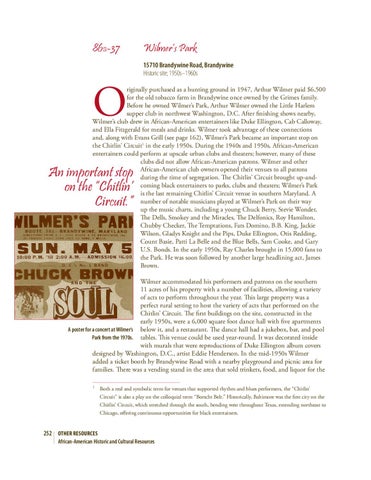86B-37
Wilmer’s Park 15710 Brandywine Road, Brandywine Historic site; 1950s–1960s
O
riginally purchased as a hunting ground in 1947, Arthur Wilmer paid $6,500 for the old tobacco farm in Brandywine once owned by the Grimes family. Before he owned Wilmer’s Park, Arthur Wilmer owned the Little Harlem supper club in northwest Washington, D.C. After finishing shows nearby, Wilmer’s club drew in African-American entertainers like Duke Ellington, Cab Calloway, and Ella Fitzgerald for meals and drinks. Wilmer took advantage of these connections and, along with Evans Grill (see page 162), Wilmer’s Park became an important stop on the Chitlin’ Circuit1 in the early 1950s. During the 1940s and 1950s, African-American entertainers could perform at upscale urban clubs and theaters; however, many of these clubs did not allow African-American patrons. Wilmer and other African-American club owners opened their venues to all patrons during the time of segregation. The Chitlin’ Circuit brought up-andcoming black entertainers to parks, clubs and theaters; Wilmer’s Park is the last remaining Chitlin’ Circuit venue in southern Maryland. A number of notable musicians played at Wilmer’s Park on their way up the music charts, including a young Chuck Berry, Stevie Wonder, The Dells, Smokey and the Miracles, The Delfonics, Roy Hamilton, Chubby Checker, The Temptations, Fats Domino, B.B. King, Jackie Wilson, Gladys Knight and the Pips, Duke Ellington, Otis Redding, Count Basie, Patti La Belle and the Blue Bells, Sam Cooke, and Gary U.S. Bonds. In the early 1950s, Ray Charles brought in 15,000 fans to the Park. He was soon followed by another large headlining act, James Brown.
An important stop on the “Chitlin’ Circuit.”
Wilmer accommodated his performers and patrons on the southern 11 acres of his property with a number of facilities, allowing a variety of acts to perform throughout the year. This large property was a perfect rural setting to host the variety of acts that performed on the Chitlin’ Circuit. The first buildings on the site, constructed in the early 1950s, were a 6,000 square foot dance hall with five apartments A poster for a concert at Wilmer’s below it, and a restaurant. The dance hall had a jukebox, bar, and pool Park from the 1970s. tables. This venue could be used year-round. It was decorated inside with murals that were reproductions of Duke Ellington album covers designed by Washington, D.C., artist Eddie Henderson. In the mid-1950s Wilmer added a ticket booth by Brandywine Road with a nearby playground and picnic area for families. There was a vending stand in the area that sold trinkets, food, and liquor for the 1
Both a real and symbolic term for venues that supported rhythm and blues performers, the “Chitlin’ Circuit” is also a play on the colloquial term “Borscht Belt.” Historically, Baltimore was the first city on the Chitlin’ Circuit, which stretched through the south, bending west throughout Texas, extending northeast to Chicago, offering continuous opportunities for black entertainers.
252 OTHER RESOURCES African-American Historic and Cultural Resources
